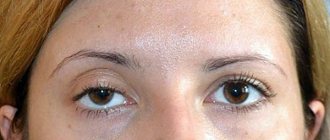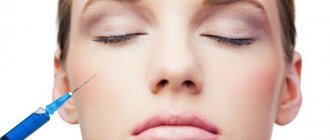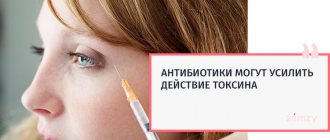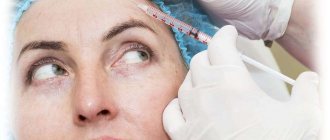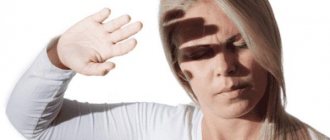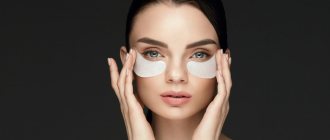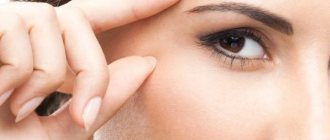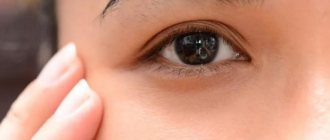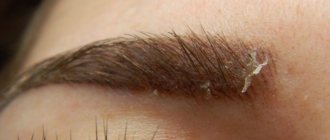“The eyes are the mirror of the soul”, “I fell in love with her eyes”, you’ve probably heard these phrases more than once. Unfortunately, the skin in this area is characterized by excessive tenderness, thinness and susceptibility to aggressive external influences. The first wrinkles in such a problem area appear quite early. It is almost impossible to eliminate them with the help of creams and masks. To cope with such age-related changes, you can introduce Botox around the eyes. Let's talk about the features and nuances of the technique, as well as the result that you can ultimately count on.
Pros and cons of Botox around the eyes
The first signs of skin aging begin to appear at 25-27 years of age. The skin around the eyes undergoes noticeable changes, since it is in this area that it is sensitive and thin. There is no fat layer underneath, and there are also a small number of sebaceous glands. Over time, the epithelium becomes thinner, the skin becomes covered with expression lines and other wrinkles. For the fair sex, such changes cause discomfort, since fine wrinkles gradually change to deeper ones and the eyes lose their former freshness and beauty.
Many women strive to get rid of wrinkles as soon as possible and resort to Botox injections for the skin around the eyes. The effective effect of this drug was known back in the 80s of the last century, when other amazing properties of Botox were discovered in the treatment of strabismus, for example, smoothing out transverse wrinkles in the forehead. Currently, the drug is actively used in cosmetology. The duration of its action lasts several months, after which Botox is eliminated from the body naturally.
Important! Botox or botulinum toxin is produced from the bacterium Clostridium botulinum. After entering the epidermal tissue, it blocks nerve impulses, while relaxing muscle fibers.
Before choosing Botox injections into the area around the eyes, you should familiarize yourself with the advantages and disadvantages of this drug. The advantages include:
- Positive effect of the drug on the orbicularis oculi muscles. Botox straightens and relaxes muscle fibers, helps to disappear small facial wrinkles or reduce the depth of deeper wrinkles.
- With the help of injections, you can lift the upper eyelid, especially if you have a problem with drooping eyelids due to physiology or age. The gaze becomes more open and the person eventually loses the habit of squinting.
- If the solution for injection is calculated correctly, the drug does not spoil facial expressions.
- Botox does not accumulate toxins and is completely eliminated from the body after 6-9 months.
- The procedure is painless, since the drug has analgesic properties.
- Botox is an effective alternative to painful plastic surgery.
The use of Botox for wrinkles around the eyes is usually opposed by those patients for whom the drug did not have any positive effect. This usually occurs due to the incompetence of a specialist, a violation of the dosage, or the use of low-quality material. In general, Botox does not have any negative effects on the body. In rare cases, unpleasant sensations may occur at the injection sites, and gradual addiction to the drug may occur with frequent use.
Methods for correcting the position of eyelids and eyebrows
There are several ways to remove ptosis caused by neurotoxin injections. The most effective, natural and safe, but also the longest in terms of obtaining the expected effect, is stimulation of the muscle that lifts the eyelid through various physiotherapeutic procedures. With such stimulation, metabolic processes in the muscle are accelerated and its innervation is restored faster. In addition, with partial ptosis, those fibers that remain active are “trained” and more effectively lift and hold the eyelid, over time taking on part of the load from the inactivated part of the muscle. As a result, ptosis goes away faster during such procedures. Practice shows that with a targeted fight against it, it is possible to ensure that the normal position of the eyelid is restored in 3-4 months.
One of the effective physiotherapeutic methods of combating drooping eyelids is galvanization.
Such procedures are often carried out for cosmetic purposes, are well tolerated by patients and are often already familiar to them. In particular, for the treatment of ptosis the following are carried out:
- Muscle massage is the simplest procedure that after several sessions the patient can master and carry out independently. It helps to activate metabolic processes in the muscle and accelerate its reinnervation;
- Microcurrents that promote the regeneration of various structures in the skin, and in some cases in the muscles. With correctly selected current parameters, they accelerate the restoration of innervation of muscle fibers;
- Thermolifting, which provides some tightening of the skin, and with it a slight lifting of the eyelid. In some cases, this is enough to eliminate the defect;
- Installation of microthreads that give a result similar to thermolifting - tightening of the skin, and with it the eyelids.
Microcurrents and muscle massage can reduce the time required to eliminate ptosis to 3-4 months, thermolifting and microthread therapy – to 2-3 months. However, in most cases it is impossible to combine these procedures due to the risk of side effects.
It is important to remember that the cost of such procedures may be greater than the cost of botulinum therapy itself. Therefore, each patient determines the feasibility of carrying them out independently.
It is also possible to administer some stimulant medications. Of these, injections of Proserin, Neuromultivit or Neuromidin, mesotherapy with DMAE drugs, and Apraclonidine eye drops are most often used. They will not give a quick and powerful result, but in a few weeks they will allow you to raise the eyelid by 1-1.5 mm. In some cases this may be sufficient.
Some drugs can lift the eyelid up to 1.5 centimeters within a few weeks.
Finally, as an option for correcting drooping eyelids, the injection of botulinum toxin into the lower part of the orbicularis oculi muscle, which ensures its closure and lowering of the eyelid, is sometimes considered. Since there is no antagonist in the muscle that lifts the eyelid, this option is not very effective, but it can ensure that the eye opens a little wider than it normally does. Visually, this compensates for the effect of a drooping eyelid.
However, this method is hardly predictable. Firstly, normally the orbicularis oculi muscle does not pull the eyelid down and therefore does not cause ptosis when the upper muscle is relaxed. That is, its relaxation will not necessarily lead to a lifting of the eyelid: a lot here depends on the distribution of the toxin in the tissues after the first procedure. Secondly, if you accidentally inject a little more than the required amount of the drug into the pretarsal part, you can deactivate it completely, which is why the patient will not be able to close the eyelids at all.
For these reasons, Botox injections into the lower part of the eye to combat ptosis are rarely done.
Injections into the lower part of the eye to lift the eyelid do not guarantee the expected result, so they are usually not done.
On a note
In case of pathological blepharoptosis (that is, one that is caused by disorders in muscle function, and not by botulinum therapy), botulinum toxin is sometimes used, but this is done only when the doctor has accurately diagnosed the causes of the condition and is absolutely confident in the effectiveness of the procedure. Normally, an attempt to lift the eyelids using Botox is ineffective due to the specific structure of the orbicularis oculi muscle. But for raising eyebrows, botulinum toxin preparations are quite suitable - with correctly selected injection points, you can relax the muscles that lower the eyebrows, as a result of which the eyebrows will rise. Here, again, high precision and professionalism of a cosmetologist is required, who will be able to raise the eyebrows by a sufficient amount, but will not allow them to be excessively lifted and the “Mephistopheles eyebrows” effect.
Surgeries to eliminate ptosis after botulinum therapy are never performed.
What is the effect of Botox around the eyes?
The positive effect of Botox injections around the eyes has been proven repeatedly, as evidenced by numerous patient reviews. When the drug is administered, the muscle tissue completely relaxes and can eliminate the following skin defects around the eyes:
- Crow's feet. These small wrinkles appear when the orbicularis oculi muscle contracts and are responsible for squinting and closing the eyelids.
- Rabbit wrinkles. Appear on the back of the nose due to frequent manifestations of emotions of anger and irritation.
- Asymmetry of the eye shape. It is expressed in the unequal arrangement of the upper eyelids.
- Lowered upper eyelids. This problem occurs when there is excessive tension in the orbicularis oculi muscles.
- Fine wrinkles on the lower eyelids. This problem requires complex treatment, since the causes of its appearance are expressed in age-related changes and due to the constant mobility of the eyelids.
Some defects in the periocular area cannot be eliminated by Botox injections. This includes tear troughs and indentations in the outer corners of the eyes.
Undesirable consequences - what they may be
In 99% of cases, undesirable consequences arise as a result of the fact that the client, chasing a low price, chose an unreliable and untested salon. The specialist did not bother to inquire about the general state of health, conduct allergy tests, or warn about taboos after the procedure. As a result, the following negative effects appear:
- drooping eyelid;
- Feeling of constant swelling;
- Bags under the eyes;
- Bruises.
These negative effects resolve on their own within a few weeks. However, if the problems are serious, then it is better to immediately contact the best specialist to avoid the risk of infection.
Indications and contraindications for the procedure
Injections with the drug are recommended not only for the presence of wrinkles of various types around the eyes, but also for the following phenomena:
- eye asymmetry;
- raised eyebrows;
- hypertrophy of the masticatory muscles;
- abnormally low position of the upper eyelid in relation to the eyeball;
- to obtain a general anti-aging effect;
- to eliminate signs of fatigue;
- as a prophylactic agent.
Important! Botox solutions are prescribed for frequent headaches, and also as an additional remedy after plastic surgery during the recovery period.
It is completely impossible to remove bags under the eyes with Botox, since the action of the drug is aimed at blocking nerve impulses in muscle tissue. To do this, it is better to use alternative types: injections with hyaluronic acid, mesotherapy, biorevitalization, ozone therapy.
Botox is contraindicated in the following conditions:
- individual intolerance to the components of the drug;
- pregnancy and lactation;
- infectious and inflammatory processes in the acute stage;
- exacerbation of chronic diseases;
- skin lesions at injection sites;
- diseases associated with muscle weakness and lethargy;
- lesions of the facial nerves;
- myopia and strabismus;
- diabetes;
- oncological diseases;
- pathologies of the endocrine system;
- use of antidepressants.
Some contraindications are temporary. The decision to perform Botox injections is discussed with a specialist, he evaluates all the risks and possible consequences.
Advantages and disadvantages
| pros | Minuses |
|
|
How many units do you need for Botox around the eyes?
Botox is an expensive drug, so before injections it is necessary to correctly calculate the dosage and find out its cost. The allowable amount of the drug is calculated in accordance with the location of wrinkles on the face and the age of the patient. For example, a patient aged 30 will need about 30 Botox injections in the area around the eyes. The drug is distributed strictly evenly on both sides of the face.
For the eye area, 5 to 15 units of Botox are typically used. The amount of solution may vary depending on the depth and number of wrinkles. It should be understood that all calculations in other botulinum toxin-based drugs differ due to the presence of a different composition, dosage and concentration.
Below is a diagram of how to apply Botox around the eyes.
Features of the event
Botox under the eyes can only be administered after a detailed examination of the patient and consultation. A competent specialist, even at the slightest risk that complications may arise, will refer you for examination. If no contraindications are identified, then electromyography can be started.
Using electromyography (exposure to current pulses), it is determined which points of facial wrinkles are the most active. After this, the doctor points out points on the face using a special marker. It is worth noting that the injection is never given directly under the eye, in which case a “devastating effect” occurs, bags under the eyes may appear after Botox, and bruises cannot be eliminated for a long time.
After this, the specialist will ask you to wrinkle your face to see exactly where the wrinkles are located. He will draw additional points where the Botox will go.
At the end of the preparatory stage, the actual administration of Botox occurs. On average, a session does not take more than 15 minutes, but if the case is severe, the procedure can take an hour (this also determines how many units of Botox will be required). Botox is injected with a short injection needle one centimeter at an angle. The procedure does not cause any discomfort; only some patients report a slight tingling sensation when the drug is administered. After this, the face is treated with a spinal anti-allergenic antiseptic to prevent the risk of infection.
How to inject Botox around the eyes
No tests are required before Botox injections. It is enough to undergo a visual examination by a specialist and assess the absence of risks and contraindications. A few days before the procedure, it is recommended to avoid the use of antibiotics, alcohol and coffee, avoid smoking, visiting baths and saunas, and heavy physical activity.
The procedure takes place in several stages:
- A saline solution is injected into the Botox bottle. The quantitative ratio may vary depending on the size of the area around the eyes and the severity of the problem.
- Botox is administered using a thin insulin needle.
- The specialist uses a marker to mark areas of increased muscle tension. The first mark should be made at a distance of 1 cm from the outer corner of the eye.
- The specialist draws a circle around the marks with a dotted line. This is the area where botulinum toxin spreads.
- The patient's skin is disinfected with antiseptics. If necessary, local anesthesia is used.
- After Botox injections are administered, the skin is lightly massaged and pressed to prevent the formation of hematomas or bags under the eyes.
- The cosmetologist must include all information about the certification of the drug, its series and expiration date in the patient’s medical card.
On average, the procedure takes from 15 to 30 minutes. An additional half hour must be spent under the supervision of a doctor. If there are no side effects, the patient is sent home.
How does the procedure work?
You need to trust exclusively an experienced cosmetologist to avoid serious problems and complications. If you choose the wrong dosage, or perform the procedure incorrectly, terrible things can happen to your skin. The whole procedure takes place in stages:
- Initially, the patient is comfortably placed in a cosmetology chair and the doctor begins to determine the sites for subsequent administration of the drug. You will have to grimace a little - this will allow the doctor to correctly select the necessary points.
- A special marker is used to make marks. Usually the doctor marks only 4 points, but everything will depend on the characteristics of the patient’s face and his needs.
- To eliminate crow's feet, new 2 points are marked near the eyes. Accuracy is extremely important here because the area is very sensitive.
- Almost all procedures that involve Botox injections are performed without anesthesia. But in general, in professional offices you will definitely be offered an option with an anesthetic - this allows you to eliminate pain and make the procedure simpler and easier. Here everything will directly depend on how the patient copes with pain - in some cases it is best not to refuse a cream with a mild anesthetic.
- An incredibly thin needle is used to perform the injections; the procedure itself very rarely lasts more than 10-12 minutes. After this, the doctor observes how the skin reacts to the injections - if everything is normal, then the client goes home. The doctor provides advice that allows you to go through the rehabilitation period calmly.
It should be repeated once again that Botox injections can only be performed by qualified specialists with the appropriate level of training and who understand the specifics of the procedure.
As we can see, Botox injections are a very sensitive but effective method of combating wrinkles and other signs of aging. It is very important to approach the procedure responsibly and contact a trusted clinic with a highly experienced specialist. Only this approach allows you to deal with all the risks and possible side effects.
If everything is done professionally, and the patient strictly adheres to the doctor’s recommendations during the recovery period, then the effect will be truly amazing. Wrinkles disappear, and the skin remains tight for a long time. You will be able to rid yourself of fine wrinkles, as well as crow’s feet - these are the problems that modern women most often face.
When does Botox work around the eyes?
The onset of action of the drug occurs at different times and depends on several factors:
- individual characteristics of the body;
- processing areas;
- depth of injection of Botox solution;
- compliance with recommendations before and after the procedure;
- specialist competence.
On average, the result of Botox after the first session is noticeable 2-3 days after the injections. The maximum effect, in which complete muscle relaxation occurs, occurs after 2-3 weeks. This can be noticed by smoother skin, the disappearance of fine wrinkles, crow's feet and a reduction in deep wrinkles.
Important! To check the effect of the drug, it is necessary to tense the muscles in the place where the injections were made. If they become motionless, then the drug is effective.
With regular injection sessions, the duration of Botox increases, and a cumulative effect occurs. Thus, it is enough to carry out about 2-3 courses per year, since the duration of the drug lasts from 3 to 6 months.
What drugs are used
Twenty years ago, there was only one drug on the market containing botulinum toxin, the well-known Botox.
Now there are many analogues that allow you to achieve exactly the same result. It is important to know their list and description in order to avoid dangerous counterfeiting.
- Botox . The drug contains botulinum toxin A itself as the main component, as well as albumin and sodium chloride solution. Made in America and imported to other countries. Rarely causes an allergic reaction. A special feature of the drug is the fact that it does not spread to neighboring locations; the result lasts for 4-7 months. Possible addictive effect.
- Botulax . Manufacturer: South Korea. According to reviews from cosmetologists and patients themselves, the medicine has a large number of side effects and a shorter lasting result after use.
- Dysport . A French drug that can, to some extent, block the functioning of non-targeted muscle fibers. Due to the low concentration of the main substance, increased doses must be administered to obtain the desired effect.
- Relatox . This domestic drug, which is no different in its properties and composition from Botox, helps get rid of expression wrinkles. During insertion, a person may experience some pain, despite high-quality anesthesia. The effect lasts about 9 months.
- Xeomin . Manufacturer: Germany. The main feature is considered to be low molecular weight, due to which an allergic reaction occurs much less frequently, and discomfort also occurs much less frequently. The medication preserves normal facial expressions.
- Lantox . The most painful botulinum toxin injections imported from China. The effect of smoothing wrinkles lasts for a long time, the price for the procedure is much lower, however, the likelihood of developing hypersensitivity increases sharply.
Recommendations after Botox under the eyes procedure
During the first 24 hours after the procedure, you should not touch the injection sites, and it is also important to avoid increased heart rate. This can provoke disturbances in facial expressions, speech, and the spread of the solution into neighboring tissues. The recovery period lasts for 2-3 weeks. At this time, the skin around the eyes is especially sensitive and must be protected from sudden temperature changes and exposure to direct sunlight. To do this, it is enough to apply sunscreen with SPF 30 or higher to your skin when going outside.
14 days after the Botox injection procedure around the eyes, you should visit a cosmetologist to ensure the correct effect of the drug on the muscles. During this period, if necessary, you can have time to further correct the results.
Degrees of ptosis
Ptosis varies in the degree of impact on the patient’s life:
- First degree (partial ptosis) – the eyelid is drooping, but the volume of the palpebral fissure is reduced by no more than 1/3;
- Incomplete (2nd degree) – a drooping eyelid covers 2/3 of the iris, accompanied by significant visual impairment (double vision, lacrimation, narrowed vision);
- Complete (3rd degree) – the palpebral fissure is completely blocked, the drooping eyelid makes it impossible to see with the affected eye.
With Botox, partial ptosis most often develops, and incomplete ptosis is extremely rare. Complete ptosis develops in severe forms of allergy to the drug.
Care for the eye area after the procedure
Throughout the entire rehabilitation period, if there is severe swelling or pain at the injection sites, it is recommended to apply ice. If bruises under the eyes occur after Botex injections, you can use ointments that promote tissue healing: Bepanten, Panthenol. You can also use compresses with heparin ointment, badyaga, or alcohol compresses with herbs.
Important! For 2 weeks, you should avoid using special anti-wrinkle creams, various scrubs and peels. Gentle care in the form of delicate moisturizing tonics is recommended.
Healing period
The healing period is 3-10 days, so the result after the procedure can be fully assessed only after two weeks. A small hematoma, swelling, discomfort or pain may occur in the area where botulinum toxin is injected.
All symptoms should go away on their own without additional intervention. If they persist and compactions occur. You must immediately consult a doctor for examination and treatment.
During the recovery period, there is a whole list of restrictions that allow you to achieve the best result:
- in the first 6-8 hours you do not need to bend over or lie on the bed or sofa;
- on the first day it is forbidden to wash your face, touch the area where botulinum toxin was injected with your hands, or carry out any procedures;
- for 14 days you should refuse to visit the solarium, beach, bathhouse or sauna;
- for two weeks, reduce the amount of tea, coffee, hot and spicy foods consumed;
- during the same period, do not drink alcoholic beverages;
- sleep only on your back, it is advisable to choose an orthopedic pillow to avoid facial asymmetry.
When applying decorative and skincare cosmetics, you must speak with your doctor individually.
What not to do after Botox around the eyes
To ensure healing is easy and painless, you should remember several rules and restrictions for the period after Botox injections.
- Go to bed or just be in a horizontal position for 3-4 hours after the procedure.
- Avoid sudden bending and performing physical exercises.
- Take vitamins B1, B2, E.
- Drink alcohol and medications that thin the blood.
- Touch the injection sites with your hands, especially massage them.
- Take a hot shower or bath, visit a sauna, sauna, or solarium.
- Be in direct sunlight.
- Do not blow-dry your hair or stand over steam while cooking.
- Do not perform cosmetic cleansing or apply cosmetics.
Those who are planning Botox injection procedures should understand that 50% of success depends on the skills of the cosmetologist, the remaining 50% depends on proper preparation before therapy, as well as compliance with all recommendations and precautions after the session.
Effect of fillers on vision
In addition to Botox, so-called fillers are widely used in cosmetology - substances that fill certain areas of the face to make them more expressive, smooth the skin, and eliminate wrinkles.
According to the results of a study conducted by South Korean scientists, the introduction of certain fillers under the skin of the face can adversely affect the functioning of the visual system. For example, injections of autogenous fat (own fat tissue) can cause blockage of the vessels that provide blood supply to the retina. In severe cases, after such cosmetic procedures, occlusion of the central vein or retinal artery may occur, which leads to blindness quite quickly.
What to do if there are bags under the eyes after Botox
People often leave reviews on the Internet that swelling under the eyes has appeared after Botox. To reduce their manifestation, it is important to monitor your diet: avoid excessive consumption of sweet, salty, spicy and fatty foods. It is these products that retain fluid and contribute to swelling. You should also limit your consumption of plain water until the end of the rehabilitation period.
Important! It is especially recommended to avoid drinking water at night, since during sleep the liquid actively enters the muscle tissue.
If after Botox injections the swelling under the eyes does not go away for a long time, you should seek help from a specialist. He will be able to correctly select cosmetics or medications that help reduce symptoms. If an allergic reaction occurs in this way, the doctor administers a special drug to accelerate the removal of Botox from the body.
Tips and tricks on the topic
Before you decide to undergo facial Botox, you need to pay attention to the features of your facial expressions. There are situations when toxin injections will not rejuvenate the face, but will lead to completely unnecessary consequences. The first thing you need to pay attention to is how much your face changes throughout the day.
If, due to fatigue, nervous tension or lack of sleep, the face takes on a tired expression with slightly drooping eyelids, a slight asymmetry of the face appears, and this sharply contrasts with the appearance of the face after rest, then Botox is undesirable - the facial muscles are already prone to decreased tone, and botulinum toxin can “fix” a tired expression. If this phenomenon began to appear only recently, then it can be corrected - soothing procedures, facial massage, and skin care will help.
Minor neurological symptoms on the face - nervous twitching of the eyelid, slight asymmetry of the face that occurs during stress or is constantly present - are reasons to undergo an examination by a neurologist, and only then think about decorating your face. In such conditions, Botox can give a completely unpredictable effect, which will take a long time to get rid of.
If the patient has already experienced drooping eyelids, but decides to undergo Botox, you need to warn the doctor about this. You should also talk about what led to the ptosis last time, what actions were taken, and how effective they were.
For Botox, as for any procedure, there are contraindications, and before you take care of your appearance, the first thing you need to do is undergo an examination and make sure that certain procedures are safe to carry out. In some cases, it makes no sense to carry out expensive cosmetic procedures - perhaps you should abandon them.
How long does Botox last under the eyes?
The duration of action of the drug is individual for each patient and depends on many factors. One of the most important is compliance with the frequency of procedures. Judging by the reviews, it is possible to achieve effective changes if Botox is injected around the eyes into the same areas. First of all, this will allow you to achieve a better effect, since the muscle fibers have not yet had time to fully recover after the previous procedure. This is also necessary to ensure that the muscles do not weaken over time and return to their original position in the form of wrinkles.
Experts say that the pronounced effect in the treatment of small expression wrinkles lasts for 3-6 months. Then, for another 2-3 months, the area around the eyes retains muscle memory and remains relatively motionless due to the absence of the habit of squinting or wincing.
Experts' opinion
The advantage of Botox is that the procedure itself takes 10-15 minutes and does not affect the ability to work, which is why in Europe it is called the lunch break procedure. However, experts advise spending more time on the preliminary examination and subsequent recovery period to reduce the risk of undesirable consequences. Even if Botox is not done for the first time, such subtleties should not be neglected.
If ptosis occurs, you don’t have to do anything if it only causes aesthetic discomfort - muscle activity recovers on its own within six months. During this time, the patient will have to endure a number of inconveniences - spoiled appearance, facial asymmetry, unwanted attention from others, but over time this will end. Those for whom it is very important to maintain a beautiful appearance need to think about treating or camouflaging ptosis.
According to statistics, ptosis occurs in 16-18% of cases, so before the procedure you should weigh your preferences and possible risks - are the problems with your face so severe that they are worth solving at the cost of the risk of getting even bigger problems. Even with repeated Botox, the risk does not decrease, so experienced patients face the same dangers as those who decided to make such changes for the first time.
Watch the video on the topic:
How often can Botox be injected around the eyes?
To maintain healthy and youthful skin around the eyes, Botox injections are allowed no more than 3 times a year. On average, 1 course of injections is carried out every 3-6 months. During this time, the drug is gradually eliminated from the body naturally. In case of persistent swelling under the eyes after using Botox, you should abandon this drug and replace it with other methods of getting rid of wrinkles or drugs with a lower concentration of botulinum toxin.
Important! If injection procedures are carried out more than 2 times a year, this can provoke excessive formation of antibodies in the body and addiction to the action of the drug.
Price
The price of Botox injections depends on many factors: the status of the clinic, the qualifications of the specialist, the characteristics of the drug and the condition of the patient’s skin at the time of treatment. The number of units also plays a role in determining the final cost.
On average, 4-16 units are required in each direction. The price for 1 is approximately 300-400 rubles. Accordingly, for one procedure you will need to pay about 3-6 thousand.
Advice: choosing a cosmetologist based on cost is extremely unreasonable. By saving on specialist qualifications, you can get the exact opposite of what you expected. In this case, the principle “better is cheaper” does not work!
Effects of Botox around the eyes
If the dosage of the drug is incorrectly selected or it is administered to the wrong muscle group, side effects may occur:
- violation of facial expressions and speech;
- redness and swelling;
- itching, rash, irritation;
- pain at puncture sites;
- eye blinking disorder;
- blurred vision;
- profuse lacrimation;
- severe pain at the injection sites;
- drying out of the mucous membrane;
- paralysis;
- asymmetry of the eyes.
There have been cases in patients where injections after Botox around the eyes did not work. Most often, this reaction occurs in those who did not follow the recommendations. Also influenced by health status, dosage, hitting the right point, qualifications and experience of the specialist.
Possible complications
Botulinum toxin type A is a poison, so if you exceed the dose, you may experience symptoms typical of botulism: difficulty breathing, interrupted speech, difficulty swallowing and weakness. These are serious complications, so tell your doctor immediately if they occur.
Also, injections in some cases cause vision problems. Since the drug significantly relaxes the facial muscles, patients sometimes have difficulty focusing on near or far objects. This is a temporary effect that goes away without medical intervention.
Predicted complications are not dangerous to health:
- mild swelling;
- redness;
- itching
More rarely, flu-like reactions occur: runny nose, chills, cough and fever. If they continue for several days, you should definitely seek medical help.
